12 Jun 2023 | Le saviez-vous
Solar charge controller is essential for optimising battery charging from photovoltaic panels. This charge controller has become increasingly popular with the growth of solar energy worldwide, and help to guarantee safety and performance when setting up an off-grid solar system.
Two types of solar charge controller are generally used to recharge a battery using solar energy: PWM and MPPT.
Each has its own specific characteristics, which we will describe in detail in this article.
In this article, you’ll find the key points to remember about these two solutions.
Definition: what is a solar charge controller?
A solar charge controller is an energy converter that connects a battery to one or more photovoltaic panels. It monitors and regulates the energy stored in the battery and produced by the panels to prevent under- or overcharging.
Solar charge controllers can be classified using two criteria:
- According to their charging voltage and current: Solar chargers can be differentiated according to their ability to handle a maximum input voltage (V) and a maximum charging current (A). These parameters can be used to determine the number of solar panels that can be connected to the charge controller without risking damage to the system.For example, 12 to 48V solutions (up to 50A) can be used in converted vehicles (motor homes, professional vehicles, etc.) or boats. Solar chargers above 48V (or above 50A) are better suited to more powerful off-grid systems.
- According to how they work: This classification distinguishes between two types of regulator: the PWM (Pulse Width Modulation) regulator and the MPPT (Maximum Power Point Tracking) regulator, which are the most widely used solutions on the market today.
PWM and MPPT solar charge controllers: what are the differences?
PWM controller
Directly connected to the solar panel and the battery, the PWM – Pulse Width Modulation – reduces the average current of the solar panel to adapt it to the battery.
This type of regulator uses an electronic switch controlled by PWM (Pulse Width Modulation) to control the average charging current of the battery. The switch opens and closes at a fixed frequency. The opening and closing times of this switch are adjusted to maintain an average current acceptable to the battery. Finally, the switch is kept open when the battery is charged.
Although these regulators are very economical, they tend to reduce the power of the solar panel and its efficiency. In fact, when the solar panel voltage is adjusted to match that of the battery, this has the effect of deviating the panel voltage from its optimum operating value.
The MPPT controller: a reliable, high-performance option
As its name suggests, Maximum Power Point Tracking is a DC/DC converter used to ensure that the solar panel operates at its maximum power point, i.e. the optimum voltage for maximum output power. MPPT relies on input voltage regulation to maintain the optimum voltage, so it recovers the maximum energy supplied by a solar panel and then converts it to recharge a battery.
This is an important feature, as it enables the battery to be recharged efficiently, with energy savings, particularly during periods of low sunlight. Given that the voltage and current of a photovoltaic panel fluctuate with the amount of sunlight during the day, this has an impact on the maximum power supplied by the PV array, and therefore on the recharging current of the solar battery.
The role of the MPPT regulator is to compensate for the variation in electricity production by continuously tracking the point of maximum power (best voltage and current combination) delivered by the photovoltaic panel to rapidly recharge the solar battery.
More advanced than the PWM regulator, the MPPT solar charger is intelligent and can increase the amount of energy drawn from the photovoltaic panel by more than 30% on average.
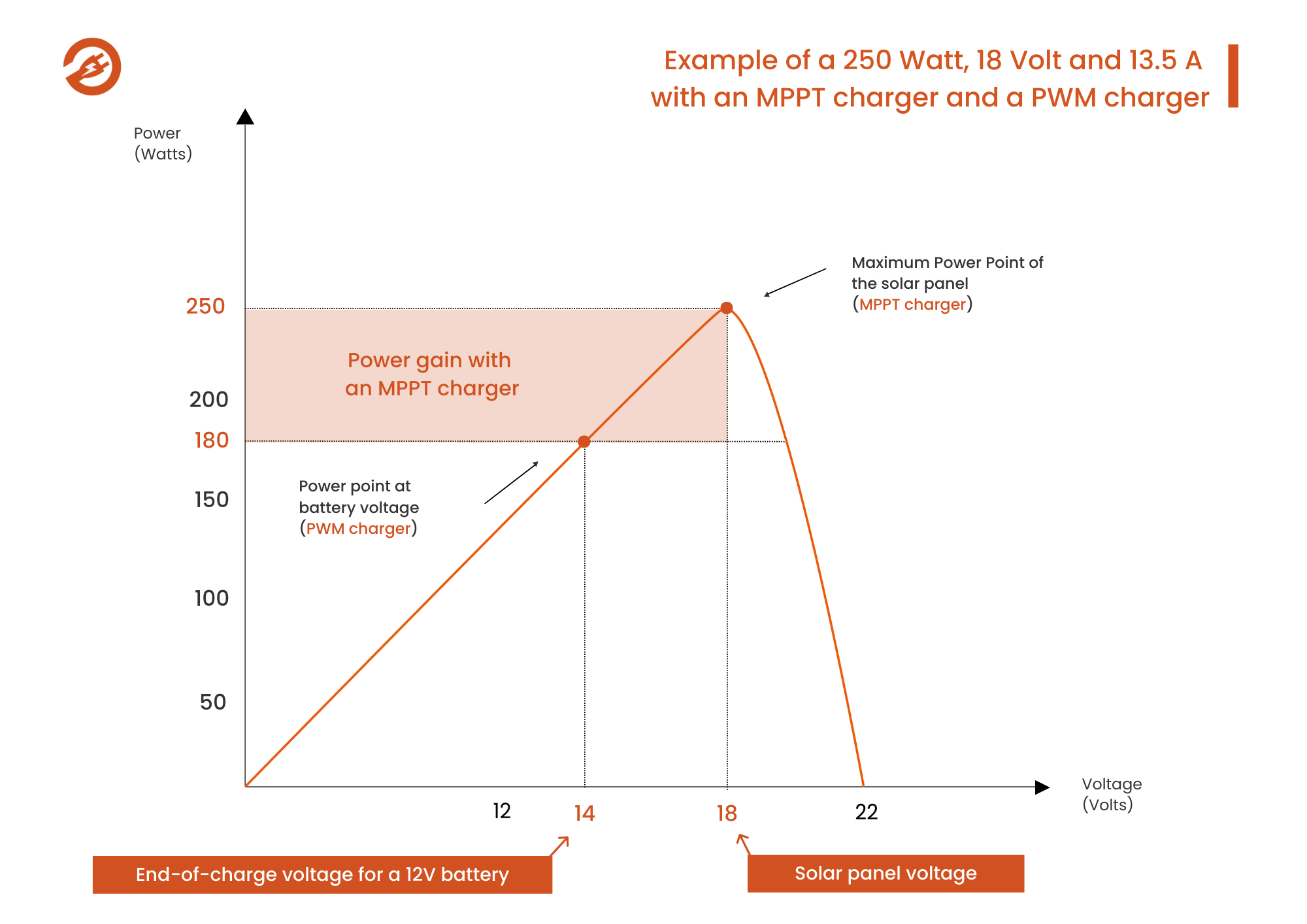
Overview of the differences between PWM and MPPT
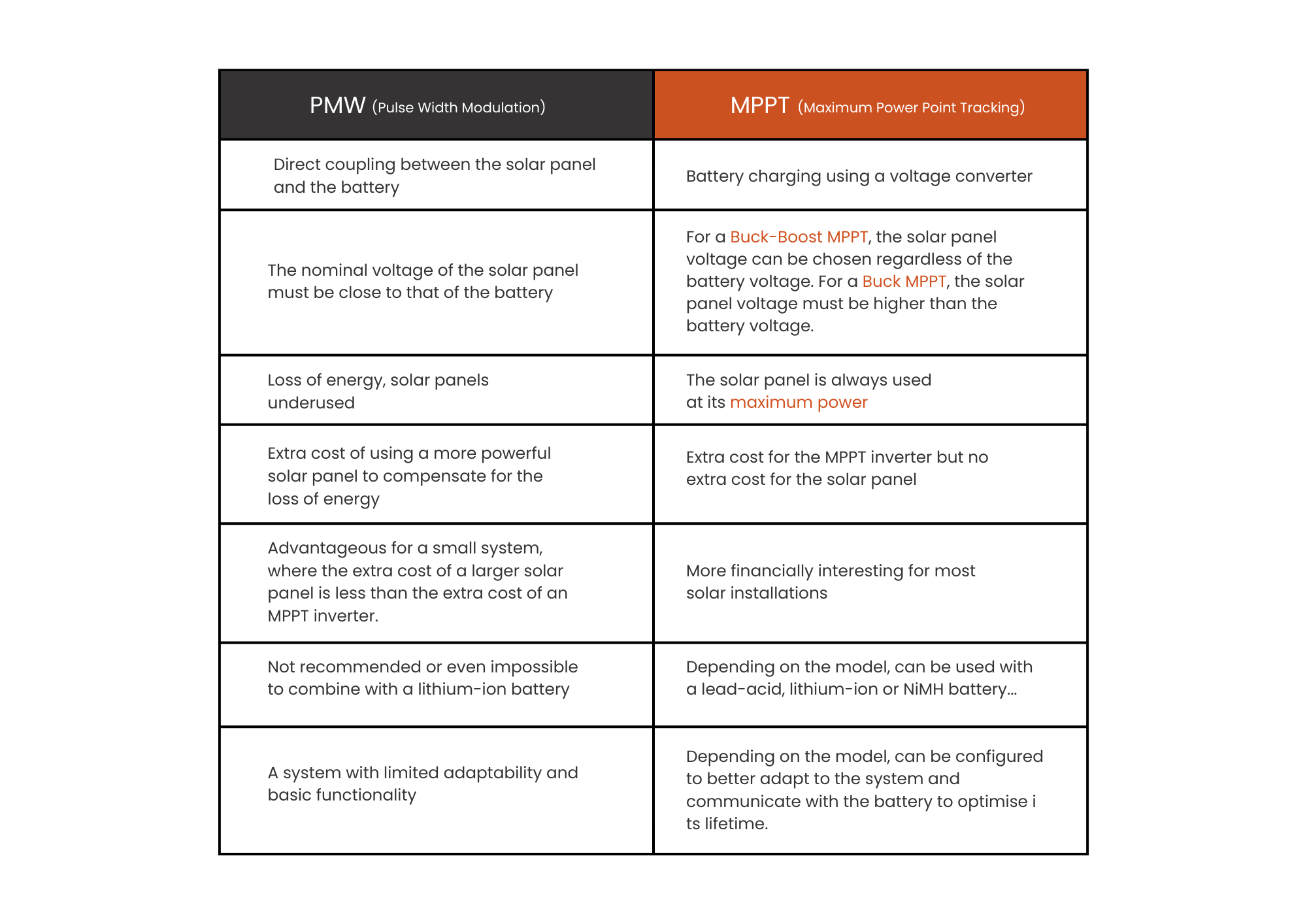
With the increasing use of renewable energies, particularly solar energy, it’s important to select a high-performance regulator that optimises the conversion of energy from a solar panel to a battery.
For some manufacturers of converted vehicles (motorhomes, boats, commercial vehicles, etc.) and specialist distributors, the challenge is to find innovative equipment that meets their needs and technical constraints. As an electronics expert, Selfenergy supports these players with tailor-made solar charge controllers. Contact our experts.
5 Apr 2023 | Le saviez-vous
With the rise of solar energy, the MPPT charger is an effective solution for safely recharging a battery from the electricity produced by a photovoltaic panel. Embedded in a mobile (vehicle, boat etc) or stationary (off-grid solar system) solution, this electronic device contains cutting-edge technology and allows the system to be freed from the conventional electrical system to improve its overall efficiency.
In this article, we will review the operation of an MPPT charger as well as its compatibility with other types of chargers, in particular the DC/DC converter-charger.
The MPPT charger
The MPPT (Maximum Power Point Tracker) charger is a solar charge controller that optimises the amount of energy produced by the solar panel and then converts it into AC or DC voltage/current.
Before we look at how MPPT works, it is worth noting that there are other solar charge controllers, including PWM (Pulse Width Modulation).
The PWM controller is a conventional controller that is less advanced than the MPPT. PWM does not use the maximum power available from the PV panel and requires the use of solar panels with a nominal voltage close to that of the battery to avoid any risk of overheating.
The MPPT charger allows it to optimise the charging process by converting the maximum solar output to match the battery voltage through DC/DC conversion. It can be connected to photovoltaic panels and batteries of different voltages.
MPPT charger and battery charging
The MPPT is primarily a DC/DC converter. That is, it converts the DC current from a solar panel to power a battery that also runs on DC current. The MPPT is specially designed to monitor the voltage and current from the solar panel in real time.
In operation, this solar charger optimises the charging of a battery using the energy produced by the solar panels. It maximises the performance of the panel by helping it to operate at the ideal voltage to produce maximum power output. The MPPT will seek a balance on the highest power point rather than going to the battery voltage and exploiting only part of the solar panel’s power. This feature allows a very significant energy gain, especially in low sunlight conditions.
Devices and operation
The MPPT can be :
- Embedded in equipped vehicles: camping-cars, vans, fire brigade vehicles, ambulances etc.
- But also embedded in a stationary devices. For example, it can be directly integrated on the electronic board and associated with other functions (BMS, LED driver, etc.) of a solar battery set that can power an autonomous system such as street lamps, outdoor displays, etc.
3 advantages of the MPPT charger
- The MPPT charger converts the direct current of a solar panel into direct current of different voltage in order to recharge a battery (on-board or stationary)
- The MPPT is an indispensable charge controller for the conversion of solar energy
- Thanks to its intelligence, the MPPT allows to increase the efficiency of the solar panel with a gain of energy stored in the battery of + 30% or even + 40% (compared to PWM)
Is there a complementarity between the MPPT and other chargers ? (AC/DC and DC/DC)
While the operation of an MPPT charger is very different from that of an AC/DC, there is a nuance to be noted in that it is MPPT and DC/DC.
Indeed, by definition the MPPT charger is a DC/DC converter which implies that the energy conversion process is similar (DC to DC). Only the energy sources used are different. The DC/DC charger is used to recharge an auxiliary battery from a main battery, whereas the MPPT uses the voltage and current produced by one or more solar panels to perform the same task. Both types of chargers can be parallelized for faster recharging of the auxiliary battery: more current and therefore power.
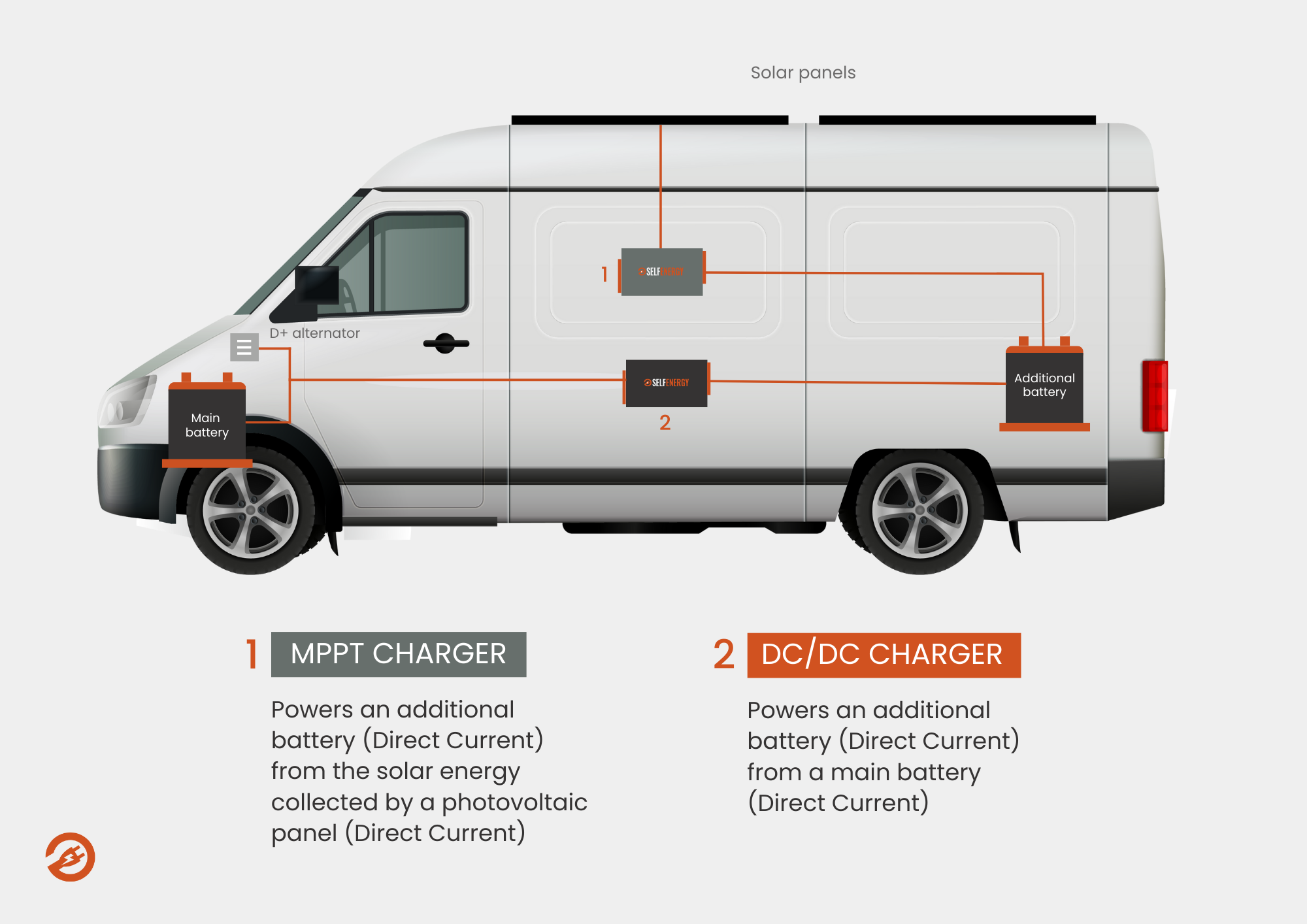
Differences between DC/DC and MPPT :

Complementarity between DC/DC and MPPT :

As an expert in energy conversion, Selfenergy is the ideal professional to accompany you in the development and industrialisation of your customised MPPT chargers.
Intelligent MPPT chargers developed by Selfenergy feature the latest innovations in terms of components, guarantee high efficiency and adapt to all battery electrochemistries (Lithium-ion, Lead, Ni-MH, etc.) with a charge current that can be adjusted according to your needs.
Would you like to know more about our chargers for your project?
Our sales team and engineers will be pleased to answer all your questions. contact us.
15 Feb 2023 | Le saviez-vous
Whether lead, gel or lithium, the auxiliary battery plays an important role in the operation of the electronics on board, for example, a motor home or boat.
Historically used for battery design, lead and gel chemistries are gradually giving way to more modern technologies such as lithium because of its many advantages.
Among these old and new chemistries, it can be difficult for manufacturers to select the most suitable for consumer needs.
Lead-acid and gel batteries: historic technologies
Lead-acid batteries
Lead is the oldest chemical element used in battery design for mobility. Widely used in motorhomes and boats, lead-acid batteries have the advantage of being more affordable than other types of batteries.
However, these advantages are limited by a lack of performance. Indeed, lead-acid batteries are limited in the amount of current they can deliver. In order to increase their capacity, it is necessary to parallelize them, but this leads to greater weight and bulk.
In addition to this limited power density, lead-acid batteries offer a small amount of energy storage and need to be replaced frequently due to their short life span. These limitations can be more costly in the long run, even if the price of these batteries is still attractive.
Gel batteries
Gel batteries use a more modern technology that uses a gel electrolyte, unlike lead-acid batteries which have a liquid electrolyte. On a boat as well as in a motor home or a professional utility vehicle, this is a real advantage of gel batteries because the gel ensures good resistance to vibrations.
The main advantage of gel batteries is their low self-discharge rate, which is essential for auxiliary batteries on a boat or motor home. Compared to lead-acid batteries, gel batteries have a higher energy storage capacity, which can make them functional over longer time periods. However, their limitation is that they are slow to recharge.
Lithium: a strategic choice for a auxiliary battery
Lithium batteries have been around for many years, but their use has recently become more widespread thanks to technological developments and all-electric solutions.
Choosing a lithium auxiliary battery allows manufacturers to guarantee their customers
- More comfort: Lithium batteries are ideal for small spaces, especially in motor homes and boats, because of their size and weight. Indeed, they have an excellent volume/power ratio compared to a lead or gel battery;
- More autonomy: Lithium is an efficient solution for a service battery because of its high energy density and its ability to withstand deep discharges (up to 80% or more) without damaging the battery cells. Unlike lithium batteries, lead-acid batteries do not provide enough voltage for normal operation of an application beyond 50% discharge;
- Longer life than a lead-acid battery: One of the most commonly used lithium grades in battery design for electric mobility is lithium LFP (Lithium Iron Phosphate). This type of lithium battery has 1,200 to 3,000 charge and discharge cycles before reaching 70% of its initial capacity. A lead-acid battery has 500 to 1200 cycles.
- Intelligent on-board electronics: Another special feature of lithium batteries is their intelligence. Indeed, they are the only batteries with a BMS (Battery Management System). This electronic card allows the battery to be monitored and to reinforce its safety during use, to boost its performance and its lifespan.
Recharging a auxiliary battery
Recharging a service battery can be done in two ways:
- With an AC/DC charger that allows the battery to be connected to a mains socket;
- With a DC/DC converter charger to recharge the auxiliary battery directly from a vehicle’s starter battery. Once the vehicle is running, the alternator emits a D+ voltage in order to automatically start the charging of the service battery by the charger-converter without any human intervention.
As an expert in energy conversion, Selfenergy offers AC and DC solutions. In particular, the design office has developed an intelligent DC/DC charger-converter suitable for all auxiliary batteries, whatever the technology on board: lead, gel or lithium.
Selfenergy’s DC converter ensures a complete recharge (acceptance/boost/absorption/floating/maintenance), reliable and secure thanks to customised charging profiles developed according to the technology of your auxiliary battery.
As an engineering design office, Selfenergy also offers its customers tailor-made developments to meet the specific requirements of each project.
Discover the Selfenergy DC Converty.
17 Nov 2022 | Le saviez-vous
Electric current exists in two forms: alternating current (AC) and direct current (DC). In alternating current, which is used to transport electricity over long distances, electrons flow in both directions in the electrical circuit to limit energy losses. In direct current, which is found in batteries, the electrons flow in one direction only and more stably.
From these forms of current come two types of charger that can effectively recharge a battery: the AC/DC charger and the DC/DC charger or converter.
In this article you will find the specifics of the AC/DC charger and the DC/DC charger in order to understand the differences between them and to select the most suitable solution for your needs.
The AC/DC charger
The AC/DC power supply applies to all kinds of electronic devices with or without a battery (television, mobile phone, electric bikes, etc.). It transforms the high voltage of the alternating current (230 V in France) into a voltage, generally lower, adapted to the supply of an electronic device or a battery.
AC/DC charger and battery charging
A battery cannot be recharged directly from AC current because of the incompatibility of its DC voltage and the AC voltage of the public electricity network. It is therefore essential to be able to convert the alternating current into direct current of the same voltage as the battery in order to recharge it. In other words, convert the current from AC to DC.
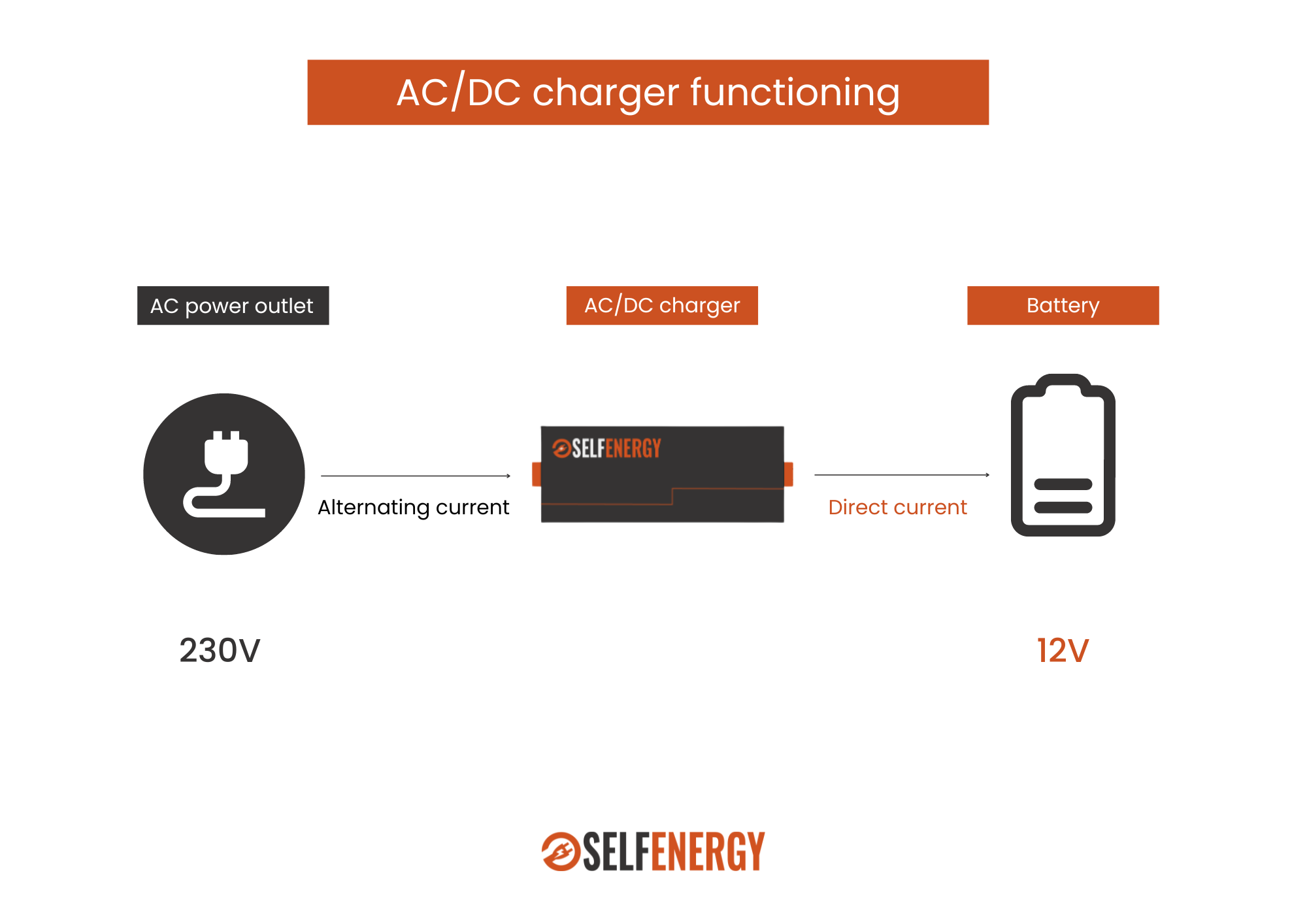
Applications and functioning
The AC/DC charger can be used to recharge all types of batteries, from the battery of an electric drill to that of an electric vehicle.
Thanks to the electronic intelligence it contains, it can convert an AC voltage from the public grid (230V) into a DC voltage from a 12V, 36V or 48V battery for example.
3 characteristics of the AC/DC charger
- Removable for certain applications (bicycles, electric vehicles, scooters, drills, robotics etc)
- Can be used in certain applications such as boats
- Converts alternating current to direct current
The DC/DC charger
DC/DC charger and battery charging
By definition, DC/DC charging is the conversion of direct current (DC) to direct current (DC). In this case, there is no need for an AC current because the energy is transformed on board the same application that already has a DC voltage.
The charger or DC/DC converter supplies an auxiliary battery running on DC from a motor battery, also running on DC.
Applications and functioning
The DC/DC charger or converter is most often used in boats, motor homes or professional vehicles (ambulances, foodtrucks, large utility vehicles, etc.) that have an engine battery and an auxiliary battery to operate the vehicle’s ancillary equipment (household appliances, lights, etc.).
The role of the DC/DC charger will be to recharge the auxiliary battery from the AC current of the engine battery. Thus converting the engine battery voltage into the auxiliary battery voltage.
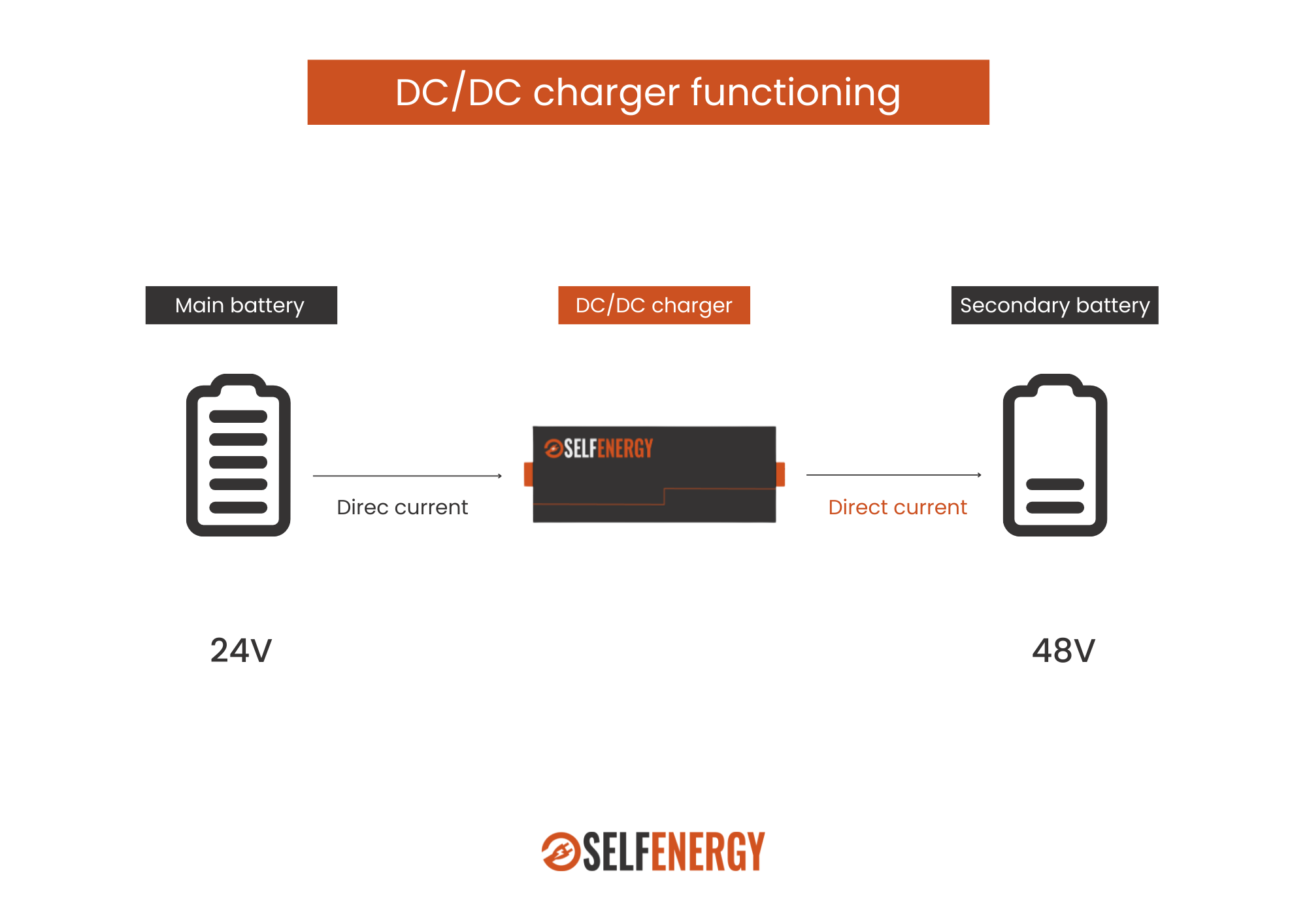
3 features of the DC/DC charger
- On board a boat or motor home
- Continuously connected to the auxiliary battery and the engine battery
- Converts direct current into direct current
AC and DC converter: Why choose Selfenergy for the design of your charger
Expert in the design and industrialization of intelligent chargers, Selfenergy accompanies you in the customed development of your AC/DC or DC/DC charger.
- Selfenergy’s Converty AC (AC/DC chargers) can transform any AC current into DC current with a voltage of up to 48V or more depending on your project and application.
- Selfenergy’s Converty DC (DC/DC chargers) garantee intelligent and efficient charging of an auxiliary battery from 12V to 48V from the engine battery.
In order to optimise the performance of your battery, Selfenergy chargers adapt to all electrochemical technologies (lithium-ion, lead-acid, Ni-MH, etc.) with a charging power of up to 1000W output. They can be parallelized to deliver more power and are IP43 waterproof rated.
Want to know more about our chargers? Our sales team and engineers are at your disposal to help you in all stages of your project. Please contact us for more information.
17 Aug 2022 | Le saviez-vous
The DC/DC charger has a significant function in the energy conversion on board a campervan, a boat or a professional utility vehicle.
In addition to recharging the auxiliary battery, it has a real impact on its performance and lifetime, regardless of its electrochemistry.
How does a DC/DC charger work?
The main function of the DC/DC charger is to recharge an on-board auxiliary battery in a vehicle with ancillary electrical and electronic equipment with a power requirement. This charging is done from any DC source such as an engine battery.
To do this, it uses 3 charging phases to transfer energy into the battery:
- Bulk phase: The battery is charged at constant current (maximum charge current) until the end-of-charge voltage is reached;
- Absorption phase: The battery is charged at a constant voltage with a gradually decreasing current to reach the full charge. A low minimum current can allow the cells of lithium batteries to be properly balanced;
- Floating phase: To ensure good battery life, the full charge voltage should not be maintained. The floating phase allows the voltage to be kept high enough to keep the battery charged without degrading it.

Why choosing a DC/DC charger for a lead-acid auxiliary battery
The limits of the splitter coupler
As the name suggests, the splitter coupler separates the engine battery from the auxiliary battery. Thanks to this separation, it ensures that the auxiliary battery can be charged from the engine battery while preserving both.
When the engine battery is charging, i.e. when the motorhome or boat is running, the separator coupler connects the two elements.
When the engine is switched off, when the voltage of the engine battery drops, the separator-coupler cuts this link in order to preserve the engine battery.
This electronic solution is most often used for lead-acid auxiliary batteries, which are less complex and less expensive. However, the use of a DC/DC charger is recommended to ensure a better charge of the auxiliary battery and a longer life.
The advantage of a DC/DC charger for a lead-acid auxiliary battery
The DC/DC charger goes further than a simple splitter coupler. It offers the advantage of being a real battery charger compared to the splitter coupler. It ensures a safer and more optimal charging of the auxiliary battery thanks to the Bulk/Absorption/Floating charge profiles.
Why choosing a DC/DC charger for a lithium auxiliary battery
The last few years have seen important developments in the battery sector. Lead-acid batteries, which were not very powerful, have progressively given way to lithium batteries (NMC, LTO, LFP, etc.) which are more powerful and have a higher energy density and a longer life span.
A necessity for good charge cycle management
Whether it is for a motor home, a boat or a professional vehicle, manufacturers are now more inclined to use lithium auxiliary batteries in order to benefit from their many advantages.
However, while these batteries are more efficient, one of the reasons for their rapid wear and tear is poor management of their charge and discharge cycles. The use of a DC/DC charger is therefore essential to optimise their life span thanks to adapted charging profiles.
Selfenergy®‘s DC Converters are designed with customised charging curves that take the form of two additional steps to provide a complete and safe charge:
- The acceptance phase: Before starting a high current charge, the Selfenergy® charger checks the battery for defects. The battery is charged at low current to allow the charger to check that the battery reacts correctly to this slow charge;
- The maintenance phase: After several days or if the charge voltage decreases, the DC Converty automatically restarts a Bulk-Absorption charge cycle to ensure that the auxiliary battery remains fully charged.
Connectivity to optimise the performance of the lithium battery
With more modern electronics and algorithmic developments, DC/DC chargers are becoming increasingly efficient and can adapt to complex batteries such as lithium batteries to optimise their performance through connectivity.
Connectivity between DC/DC charger and battery: What is it?
Connectivity refers to the ability of a charger to interface with the battery through a communication protocol such as CAN Bus. Through this protocol, the charger’s electronic board communicates with all the elements of the system, including the battery’s Battery Management System (BMS).
The BMS is an electronic battery management board that manages and monitors all the elements that make up the battery in real time. Today, on-board chargers such as Selfenergy®’s Converty DC are able to retrieve important information about the battery, such as its state of charge (SOC) or state of health (SOH), through the CAN Bus communication protocol to ensure a complete and safe recharge of the battery.
Do you need chargers and energy converters for your batteries? Select our customisable 12V, 24V and 48V DC/DC chargers and converters as well as our customised offer.







